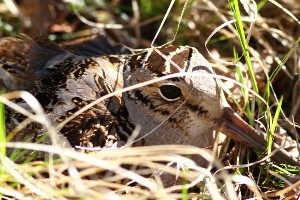Student: none (this is a pilot project)
Principal Investigators: Dan Sullins (Kansas State University) and David E. Andersen
Funding: Initial funding provided by Kansas State University and the MNCFWRU
Collaborators: Tom Cooper (USFWS), Kyle Daly (USFWS), Bailey Petersen (MNDNR)

American woodcock primarily breed in the Upper Midwest and Northeast U.S. and adjacent southern Canada—areas historically without native earthworms due to recent glaciation. However, existing studies of woodcock diet suggest that earthworms are their primary prey, even though exotic earthworms have only recently invaded their northern breeding grounds. The apparent paradox of woodcock primarily relying on prey that was not historically available on their breeding grounds has been a source of debate, and the historical (pre-earthworm invasion) and current role that earthworms may play in driving woodcock population dynamics is largely unknown. To help understand this paradox, the Minnesota Cooperative Fish and Wildlife Research Unit is collaborating with Dr. Dan Sullins (Kansas State University) and volunteers in Minnesota to collect woodcock fecal samples and use DNR bar-coding to assess woodcock diet. In 2021, we developed sampling protocols and collected samples in northeastern, central, and east-central Minnesota and in spring 2022, collaborated with woodcock banders to collect samples from broods throughout the state. DNA analyses are ongoing, but we hope will shed light on woodcock diet on their northern breeding range, and also indicate what woodcock are eating in areas where exotic earthworms may not be available (e.g., in poor, shallow soils in northeastern Minnesota and during periods of drought when earthworm availability is reduced).
American woodcock primarily breed in the Upper Midwest and Northeast U.S. and adjacent southern Canada—areas historically without native earthworms due to recent glaciation. However, existing studies of woodcock diet suggest that earthworms are their primary prey, even though exotic earthworms have only recently invaded their northern breeding grounds. The apparent paradox of woodcock primarily relying on prey that was not historically available on their breeding grounds has been a source of debate, and the historical (pre-earthworm invasion) and current role that earthworms may play in driving woodcock population dynamics is largely unknown. To help understand this paradox, the Minnesota Cooperative Fish and Wildlife Research Unit is collaborating with Dr. Dan Sullins (Kansas State University) and volunteers in Minnesota to collect woodcock fecal samples and use DNR bar-coding to assess woodcock diet. In 2021, we developed sampling protocols and collected samples in northeastern, central, and east-central Minnesota and in spring 2022, collaborated with woodcock banders to collect samples from broods throughout the state. DNA analyses are ongoing, but we hope will shed light on woodcock diet on their northern breeding range, and also indicate what woodcock are eating in areas where exotic earthworms may not be available (e.g., in poor, shallow soils in northeastern Minnesota and during periods of drought when earthworm availability is reduced).